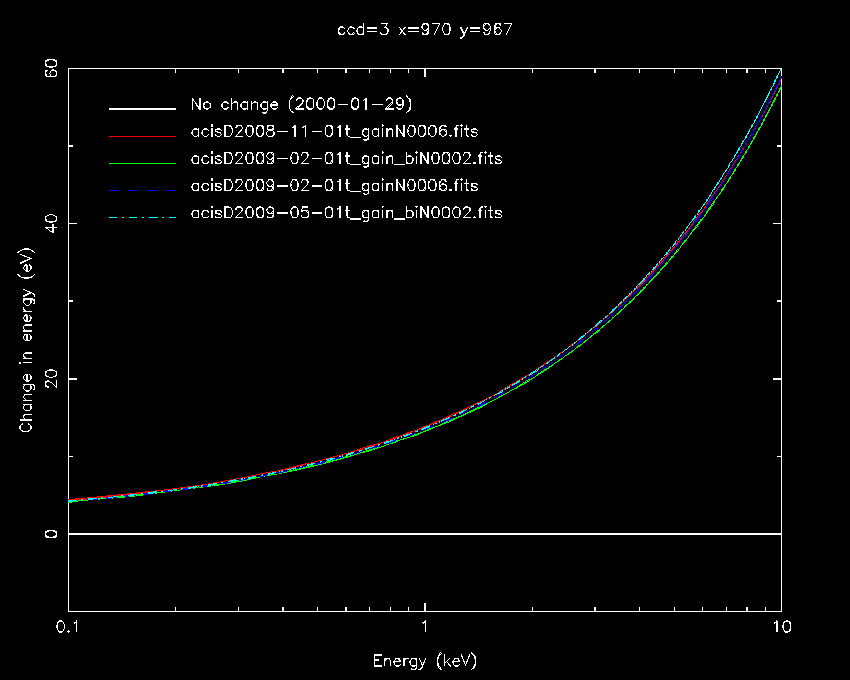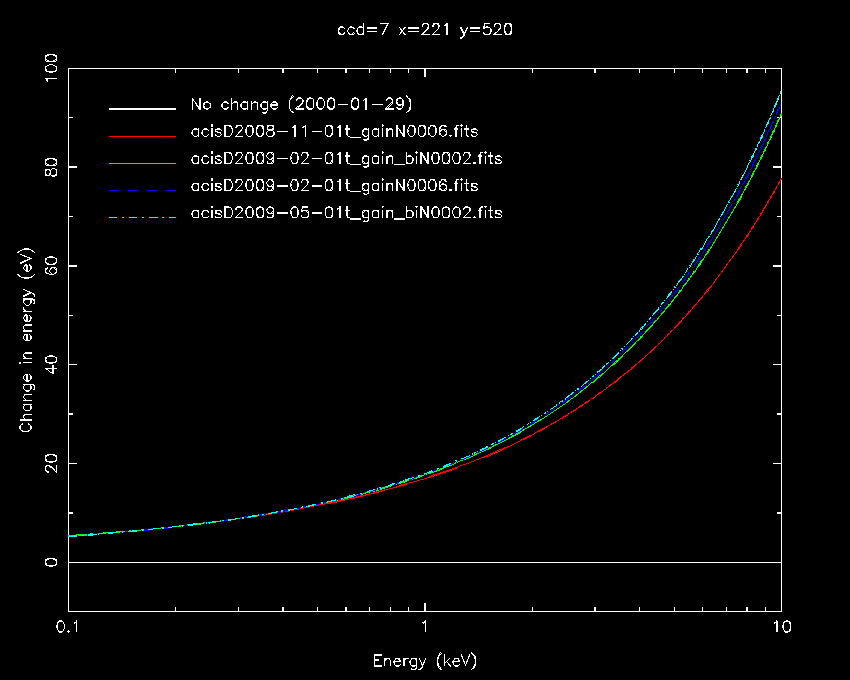<Return
to CalDB Release Notes>
CalDB
PUBLIC
Release Notes
Effective Date: (UTC) 2009-09-16T13:45:00
SDP Installation Date:2009-09-16T13:45:00
Public Release Date: 17 September 2009
Version:
4.1.4
Release
Type: PUBLIC
I. Introduction
CaldB 4.1.4 is an upgrade
to all previous CalDB4 versions 4.1.x. It includes the following
upgrades:
ACIS T_GAIN Epoch 38
(01 May through 30 July 2009)
Header changes for
ACIS -90C Level 1 calibration files applicable to engineering data
from July-Aug 1999.
Addition of new ACIS
-120C Level 1 calibration files applicable to CTI calibration data
only.
Only the new ACIS T_GAIN
affects current science observations and processing in any immediate
way. See the technical details (Section III below) for information
regarding effects of these new calibrations on analysis.
User Documentation:
"How
CalDB 4.1.4 Affects Your
Analysis"
http://cxc.harvard.edu/ciao/releasenotes/ciao_4.1.2_release.html#HowCALDB4.1.4AffectsYourAnalysis
II. Summary of Changes
A.
ACIS T_GAIN Epoch 38
LOCATION:
$CALDB/data/chandra/acis/t_gain/
FILENAMES:
acisD2009-02-01t_gainN0005.fits
acisD2009-02-01t_gainN0006.fits
acisD2009-05-01t_gainN0002.fits
acisD2009-05-01t_gain_biN0002.fits
acisD2009-05-01t_gain_secN0002.fits
The
Epoch 38 (May- Jul 2009) have now been released as indicated above;
hence the Epoch 37 interpolations (the 2009-02-01 filenames above,
applicable for observation dates Feb through May 2009) are now
finalized. The previous epoch N0002 files have been demoted to "BAD"
status, though they are still in the circulation with the CalDB, just
in case they are needed for comparison to earlier analyses. See the
Tech Details below for information on the degree of effect versus
energy that the new corrections will have on your particular ACIS
datasets. These new files will only affect data with DATE-OBS after
2009-02-01T00:00:00. All earlier data are unaffected by this
change.
Users analyzing observations with DATE_OBS later than
2009-02-01 are encouraged to reprocess their Level 1 events data
through Level 2, to verify whether or not their previous analysis
results are at all affected by these new data. The plots in Tech
Details section III.A give some a priory
indications of how these data will affect
them.
Pipes/Tools affected:
SDP/CIAO tool
acis_process_events
Threads
affected:
Any thread that employs acis_process_events with the
parameter apply_tgain set
to "yes", which is the default state.
Specifically,
"Reprocessing to create a new (ACIS) L2 events
file"
http://cxc.harvard.edu/ciao/threads/createL2/index.html#acis
B.
ACIS -120C SECONDARY Level 1 calibration files
BRANCH:
$CALDB/data/chandra/acis/
CODENAME: BADPIX
FILENAMES:
acisD2000-11-28badpixN0005.fits
acisD2000-11-28badpix_secN0005.fits
CODENAME: CTI
FILENAMES:
acisD2002-08-01ctiN0006.fits
acisD2002-08-01cti_secN0006.fits
CODENAME: DET_GAIN
FILENAME:
acisD2000-01-29gainN0006.fits
acisD2000-01-29gain_cti_secN0006.fits
For the pre-existing files
(the ones without “_sec” in their filenames, the only change is
to add the boundary condition for OBS_MODE in the headers, set to
allow OBS_MODEs POINTING, RASTER, SCAN, and SLEW, i.e., everything
but SECONDARY. For the “_sec” files, the FP_TEMP boundary
condition is extended to include all applicable ACIS FP_TEMPS
(148.15-188.15 Kelvin), and OBS_MODE is limited to SECONDARY. Hence
only the ACIS CTI ECS exposures taken during radiation zone passes on
each orbit will use these datasets, unless some other SECONDARY mode
observations are set up in the loads. This excludes the problem of
occasional processing errors where a CTI check was done with FP_TEMP
drifting high in the rad zone due to bright earth exposure on the
ACIS passive radiator.
Pipes/Tools affected:
CIAO tool
acis_process_events
Threads
affected (for ACIS OBS_MODE=SECONDARY data only)
"Reprocessing
to create a new (ACIS) L2 events
file"
http://cxc.harvard.edu/ciao/threads/createL2/index.html#acis
C.
ACIS -90C Level 1 calibrations affecting OAC (July-Aug 1999) ERs
BRANCH:
$CALDB/data/chandra/acis/
CODENAME: BADPIX
FILENAME:
acisD1999-07-22badpixN0005.fits
CODENAME: DET_GAIN
FILENAME:
acisD1999-07-22gainN0002.fits
CODENAME: FEF_PHA
FILENAME:
acisD1999-07-22fef_phaN0002.fits
CODENAME: OSIP
FILENAM:
acisD1999-07-22osipN0004.fits
These changes affect
reprocessing of ACIS data with the focal plane temperature set to
either -90C or -120C during the Orbital Activation and Checkout (OAC)
phase of the Chandra mission, during July and early August 1999. The
alterations were made to the boundary conditions for FP_TEMP, to
allow the two different temperature ranges (148.15-158.15 and
178.15-188.15 Kelvin) for the files above, as well as to reset the
calibration validity end date (CVED0001) to the exact date (UTC)
1999-08-13T05:45:45, the same value as DATE-END for ER Obs_ID 62566,
the final ER taken at -90C during OAC. These changes do not affect
any science observations, as they affect data taken before the
Chandra Sun Shade Door was opened.
Pipelines affected: ACIS
L1 pipeline acis_process_events (gainfile only)
Currently
the ACIS BADPIX files are not selected by FP_TEMP, but this may
change in the future. FEF_PHA and OSIP files have had the same header
changes for consistency and completeness in the CalDB.
III. Technical
Details
A. ACIS T_GAIN Epoch 38
The total corrections versus photon energy for epoch 37
files, in eV, are given in the figures below, for the ACIS-I and
ACIS-S aimpoint positions specifically. We note here that corrections
a various points across the chip surface may be rather different,
even very significantly so, from these results.

Fig.
1: Comparison of the total change in eV due to the Epoch 35, 36, and
37 T_GAIN files, for the I3 aimpoint. The red curve is for Epoch
35,
and interpolates between the epoch 35 and 36 corrections at
the mid-point (average). The 2008-11-01 files are for Epoch 36. The
t_gainN0006.fits file
replaces the t_gain_biN0002.fits file, and
there is very little change at this location on the chip by this
upgrade. Other locations will vary more
significantly. The
acisD2009-02-01t_gain_biN0002.fits file is a flat, non-interpolating
file, and will be upgraded after Epoch 38 has been
completed (May
1-Aug 31, 2009).

Fig.
2: A similar plot for the aimpoint of the BI chips S3, with the CTI
corrections applied to the data. For this location and chip the
2008-08-01 file
upgrade is more significant (difference between
the solid green and dashed blue curves), but mainly at the highest
energy points above 6 keV. For
the new flat file (cyan dashed
curve) more correction seems to be required above 5 keV than in the
previous epochs, but not out of the ordinary. This
result may be
modified by the next epoch data as well.

Fig.
3: The S3 aimpoint corrections for the case where the BI chips are
NOT CTI-corrected at all. (The N0005 files.) As is usually the
case,
the corrections are more scattered over the full range for
the non-CTI case. However while these variations are significant
relative to the
0.3% gain setting standard for the calibrations,
they are not unusually strong. The cyan dashed curve indicates the
strongest variation in
correction values over the range, but again
it may be modified in the next epochal release.
<Return
to CalDB Release Notes>


